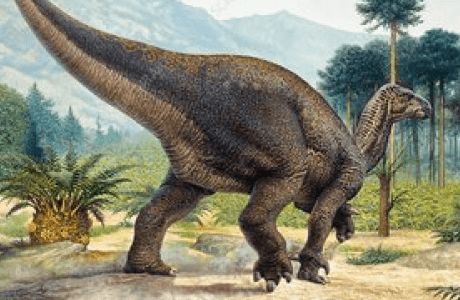Iguanodon

An Iguanodon stands on its powerful hind legs and reaches for a flowering plant—something new on Earth at the time, around 130 million years ago. The dino uses its hands to pull the plant closer to its beak. Its mouth is full of curved and grooved teeth for grinding plants, and its jaws can move both up and down and side to side as it eats. The dinosaur takes a tasty bite.
New creature
Iguanodon was one of the first dinosaurs described by scientists after its fossilized tooth was found in southeast England in 1822. (The word “dinosaur” wasn’t even used until 1842.) People had been finding dinosaur fossils for thousands of years, but they didn’t know what they were. So when a paleontologist saw the fossil, he first thought it was the tooth of an extinct giant iguana and named the animal Iguanodon, meaning—of course—“iguana tooth.” Little by little, scientists began to understand that Iguanodon wasn’t an iguana but a whole new type of animal, one that didn’t exist anymore. In fact, this animal lived between 130 and 110 million years ago in what’s now Europe.
It was about the same height as an African elephant but weighed twice as much, so Iguanodon needed strong leg bones to support its bulk. Scientists think the dino could walk either on two feet or all fours—unique for dinosaurs. On its hind legs, Iguanodon had three short, thick toes that were probably padded to cushion its feet from its massive weight.
Thumb request
When paleontologists went back to the spot where the fossilized tooth was found, they discovered more fossilized bones, including one that looked like a horn. Scientists first mistakenly put the object on Iguanodon’s head like a rhinoceros. But later, experts realized it was actually a spiky thumb that belonged on the dino’s hand. Iguanodon might’ve used the digit to defend itself or dig into fruits and seeds.
